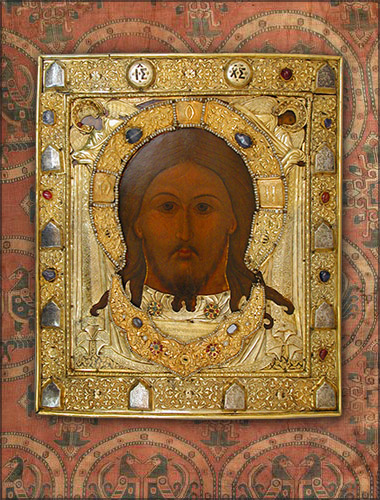Ivory Triptych with the Deësis (Harbaville Triptych; GW 2, no. 33). Musée du Louvre, Paris (OA3247). Tenth century. 140cm (5.5 inches) x 278cm (11 inches) when open.
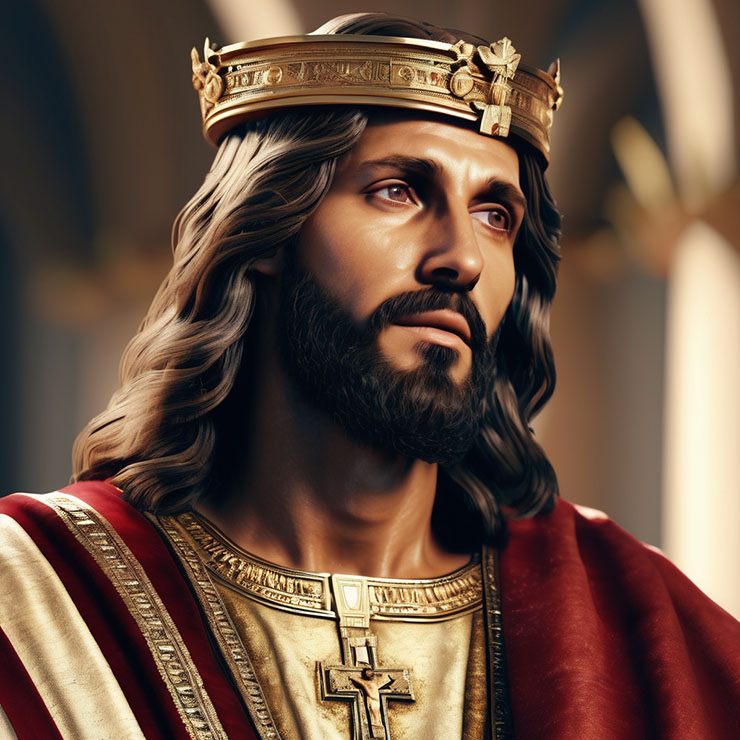 Constantine VII Porphyrogenitus (left) was the fourth Byzantine emperor of the Macedonian dynasty, reigning from 6 June 913 to 9 November 959. He was the son of Emperor Leo VI and his fourth wife, Zoe Karbonopsina, and the nephew of his predecessor Alexander. Constantine VII died at Constantinople on 9 November 959 and was succeeded by his son, Romanos II. He was called Porphyrogenitus because he had been born in the "Purple Chamber". Constantine was handsome with dark hair, milky white skin and a fine aquiline nose. His eyes were deep blue and he had ruddy cheeks. He stood tall and straight like a cypress tree and had broad shoulders.
Constantine VII Porphyrogenitus (left) was the fourth Byzantine emperor of the Macedonian dynasty, reigning from 6 June 913 to 9 November 959. He was the son of Emperor Leo VI and his fourth wife, Zoe Karbonopsina, and the nephew of his predecessor Alexander. Constantine VII died at Constantinople on 9 November 959 and was succeeded by his son, Romanos II. He was called Porphyrogenitus because he had been born in the "Purple Chamber". Constantine was handsome with dark hair, milky white skin and a fine aquiline nose. His eyes were deep blue and he had ruddy cheeks. He stood tall and straight like a cypress tree and had broad shoulders.
The triptych was made around 940 under the direction of the Emperor himself. After it was completed it remained in the personal possessions of the Emperor. On his death it was transferred to the Imperial patrimony and was kept in the Imperial bedchamber. It passed down to Constantine's son Romanos II and hence in the personal treasury of the emperors until 1204 when it was looted by the crusaders in their sack of the city. A French knight headed for the Bukoleon Palace by sea and entered the private Imperial quarters. He claimed he was there to protect French Princesses who were married into the Imperial family who were lodged here. The Bukoleon Palace was nestled on the seashore and accessible by staircases there. The Harbaville Triptych arrived in France and remains there until today. You can see it on display in the Musée du Louvre in Paris.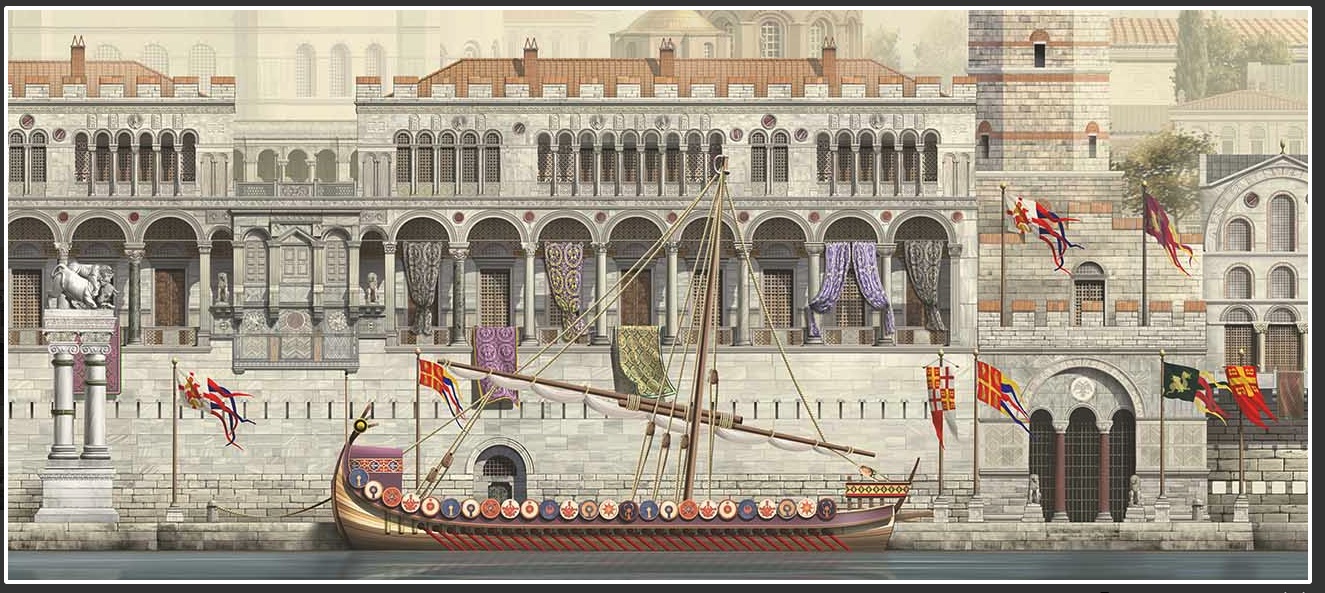
The Triptych is made of African Elephant ivory, which was sold by weight to the artists who made it. It was the same cost as lapis pigment which was sold in special Imperial stores. Ivory was sold outside of the control of city officials. If you could find it you could buy it. Bone was also used, especially in caskets and boxes. Decorative pieces - like rosettes - were made of bone and combined with figurative friezes in ivory. The cost of carving the ivory increased the cost of the ivory by only 20%. It was carved by workers in wood using the tools of their trade, the Byzantines were very fine woodworkers. They must have used special lenses to carve the very fine detail of the Triptych which was done with a needle. The ivory is carved so very thinly, light can be shown through it.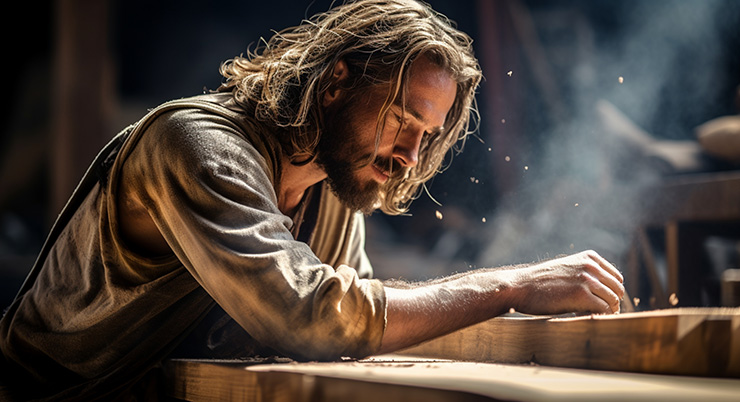
The workers ere employed as family concerns with multiple generations working in small factory in the commercial quarter of the city around the Forum of Constantine. They would have had their own storefront which was open to the public.
They would have contracted directly with palace officials to contact and deliver the final work. These bureaucrats were often eunuchs and highly educated in art and culture. Emperor Constantine was a great authority in art and history, he was personally involved in the design of the Triptych the selection of the saints and the style of its execution. He was also a painter of great talent and would have given the craftsman drawings of what he wanted. Constantine designed his own gold coinage which bears his image in fine detail. He designed gold enamels and redesigned the Imperial regalia, robes, thrones and orbs.
It would have taken around six months to make. There are roughly 200 pieces of Byzantine ivory that survive until today. Production lasted around 100 years until supplies of ivory ran out.
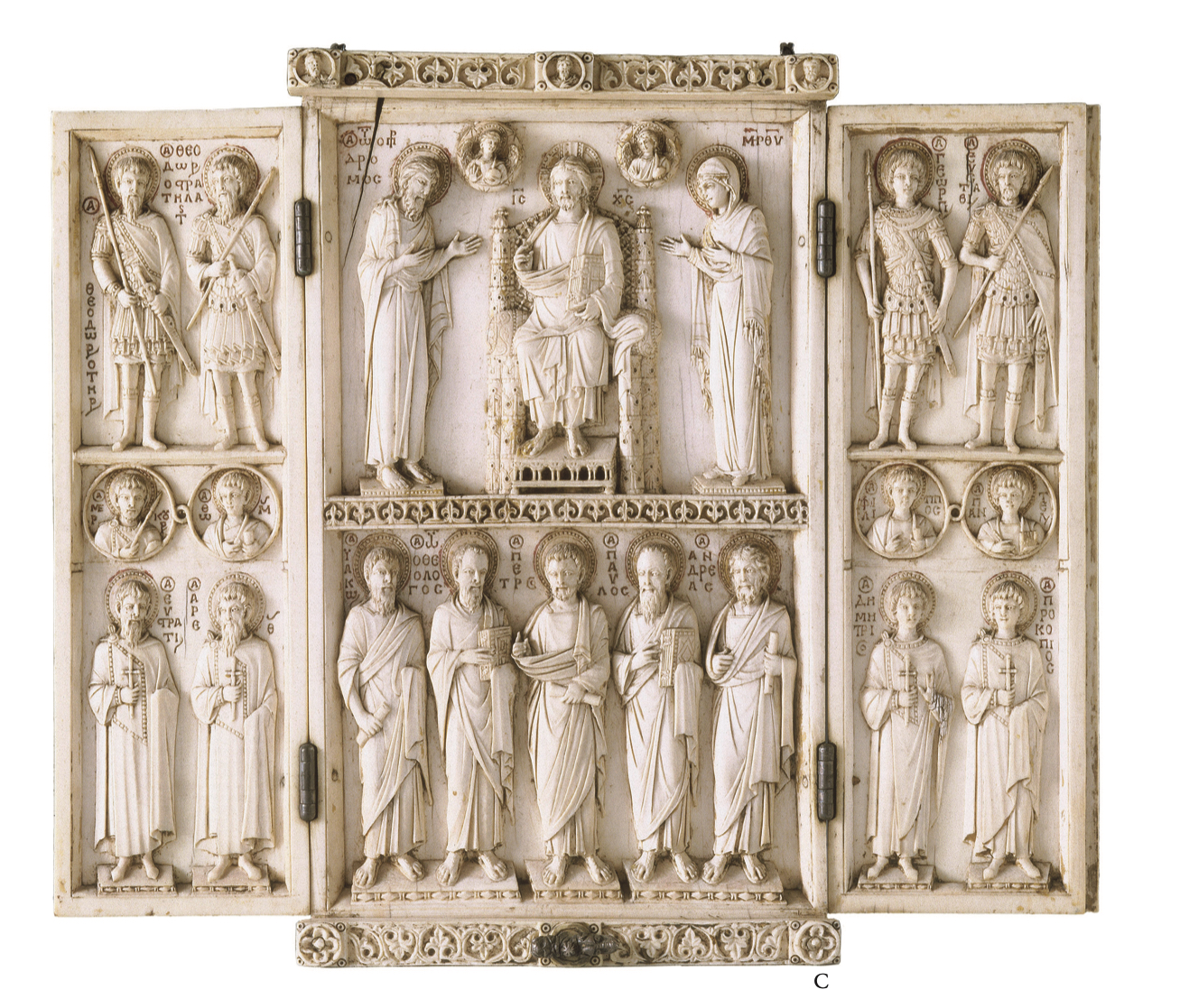 FRONT - below the Deesis are 5 of the apostles with Peter in the center
FRONT - below the Deesis are 5 of the apostles with Peter in the center
.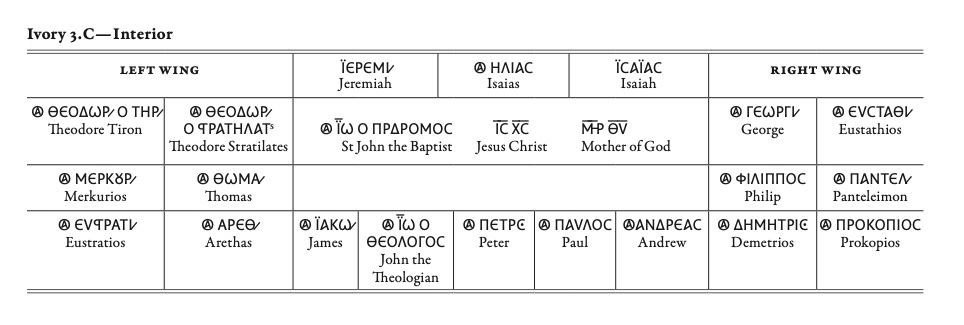
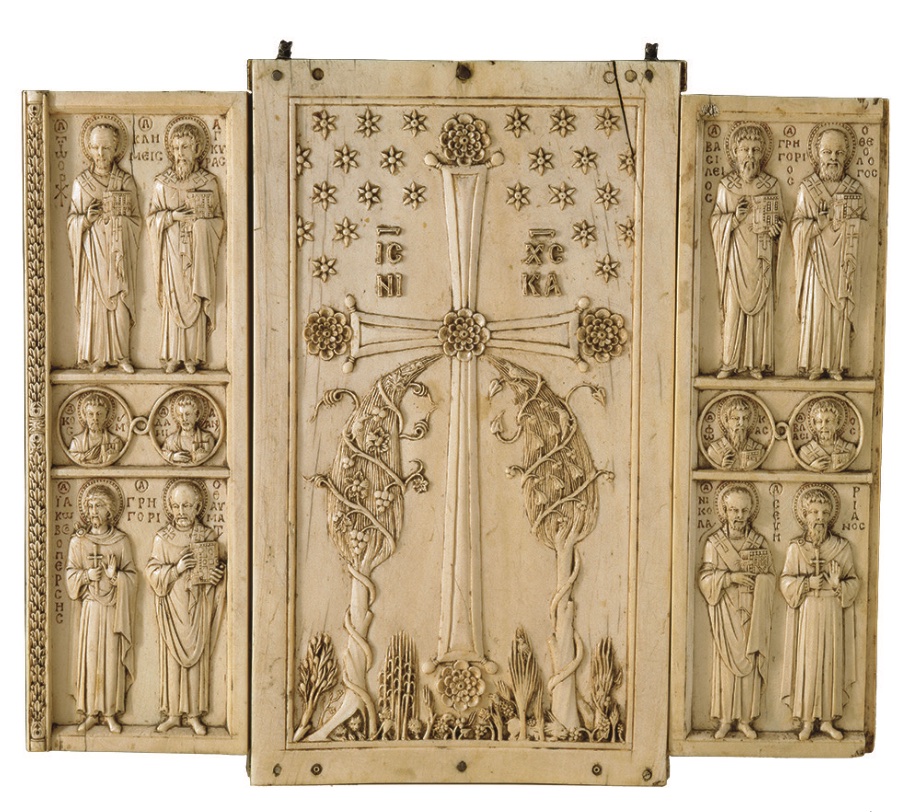
BACK

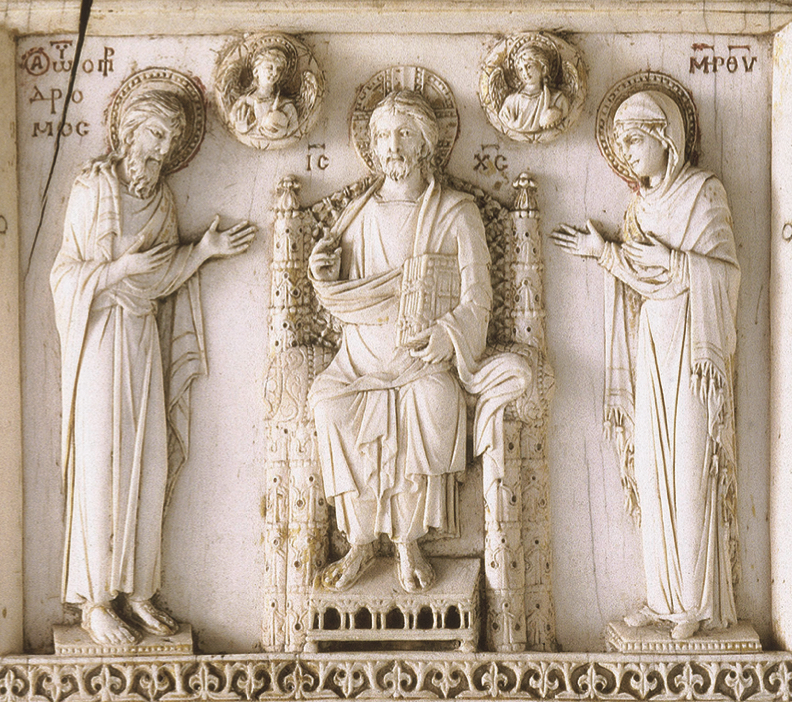
Central Deesis of St. John The Baptist or Forerunner, Christ and Mary the Theotokos. Deesis a traditional iconic representation of Christ in Majesty or Christ Pantocrator: enthroned, carrying a book, and flanked by the Virgin Mary and St. John the Baptist, and sometimes other saints and angels. Mary and John, and any other figures, are shown facing towards Christ with their hands raised in supplication on behalf of humanity. 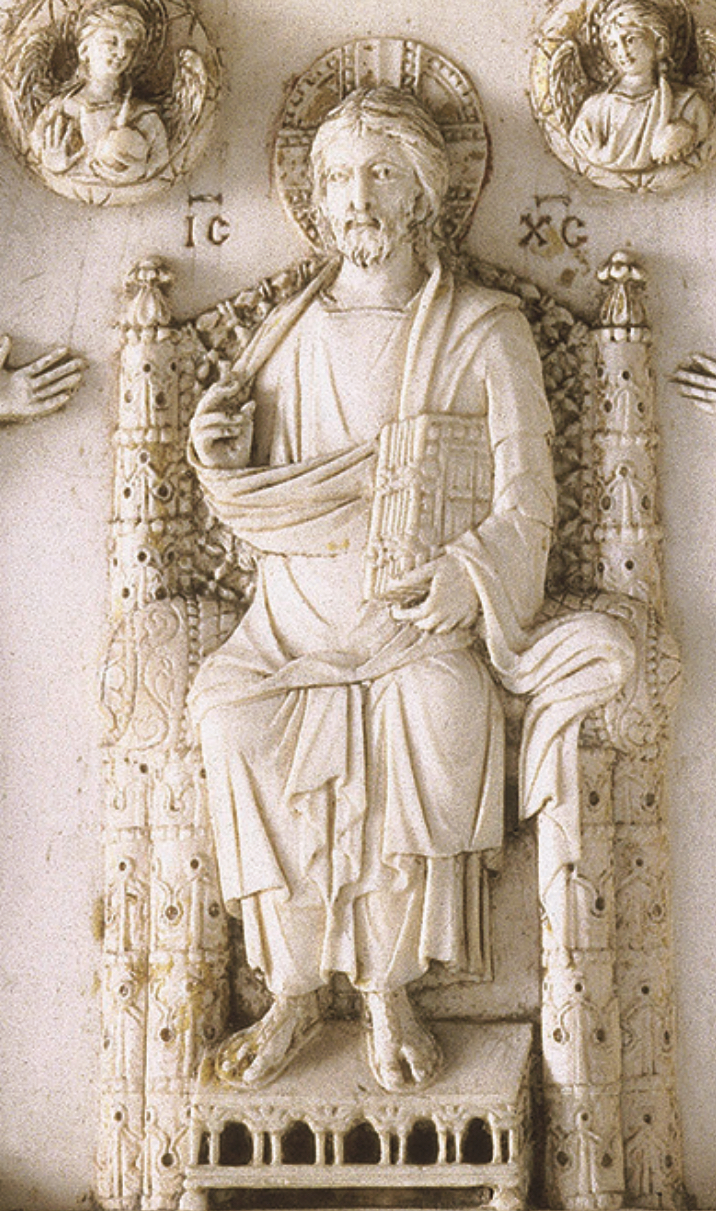 The imperial throne was made of gilt-silver, set with precious stones and pearls is a replica of Constantine's own. Its columns are decorated with acanthus leaves topped by rosette finials. The top of the stiff back of the throne is curved with pairs of silver gilt disks separating enameled beads; the back has a golden enameled pattern of more beads wired together with silver. The back of the great altar of Hagia Sophia was also set with this gilt silver curtain. The pillow on the seat is silk with gold embroidery from the Imperial gold thread working workshops.
The imperial throne was made of gilt-silver, set with precious stones and pearls is a replica of Constantine's own. Its columns are decorated with acanthus leaves topped by rosette finials. The top of the stiff back of the throne is curved with pairs of silver gilt disks separating enameled beads; the back has a golden enameled pattern of more beads wired together with silver. The back of the great altar of Hagia Sophia was also set with this gilt silver curtain. The pillow on the seat is silk with gold embroidery from the Imperial gold thread working workshops.
Christ holds a gilt silver gospels set with enamels, gems and pearls. There are two clamps to securely close it. His feet rest on a arcaded gilt silver footstool with a woven carpet top, An arcade is a succession of contiguous arches, with each arch supported by a colonnade of columns or piers.
Above Christ are two archangels, unmarked but obviously Michael and Gabriel, holding crystal orbs. They are set in celestial roundels made of stars. The hands do not match, which I think is an error. The angel on the right has the correct placement.
There is also an error in the footstool. The back left corner is cut off.
Photos: © Antony Eastmond (B); © RMN-Grand Palais (Musée du Louvre)/Daniel Arnaudet
Sources:
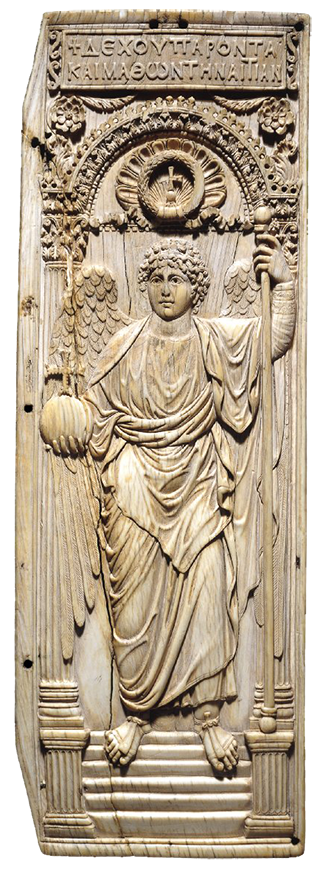
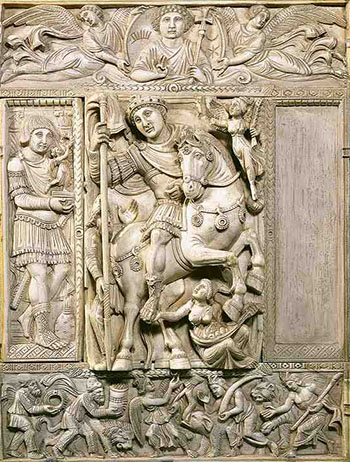
 click here for icons of christ
click here for icons of christ click here for icons of the theotokos
click here for icons of the theotokos click here for icons of angels
click here for icons of angels click here for icons of saints
click here for icons of saints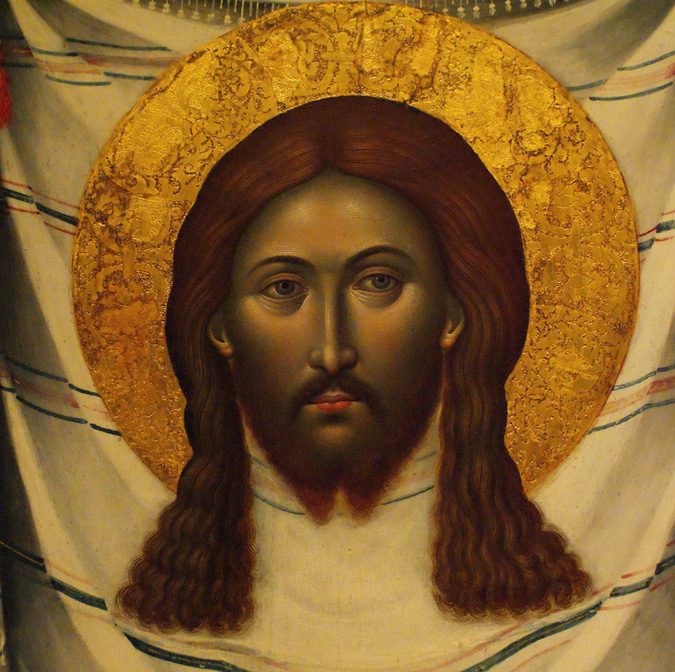

 Constantine VII Porphyrogenitus (left) was the fourth Byzantine emperor of the Macedonian dynasty, reigning from 6 June 913 to 9 November 959. He was the son of Emperor Leo VI and his fourth wife, Zoe Karbonopsina, and the nephew of his predecessor Alexander. Constantine VII died at Constantinople on 9 November 959 and was succeeded by his son, Romanos II. He was called Porphyrogenitus because he had been born in the "Purple Chamber". Constantine was handsome with dark hair, milky white skin and a fine aquiline nose. His eyes were deep blue and he had ruddy cheeks. He stood tall and straight like a cypress tree and had broad shoulders.
Constantine VII Porphyrogenitus (left) was the fourth Byzantine emperor of the Macedonian dynasty, reigning from 6 June 913 to 9 November 959. He was the son of Emperor Leo VI and his fourth wife, Zoe Karbonopsina, and the nephew of his predecessor Alexander. Constantine VII died at Constantinople on 9 November 959 and was succeeded by his son, Romanos II. He was called Porphyrogenitus because he had been born in the "Purple Chamber". Constantine was handsome with dark hair, milky white skin and a fine aquiline nose. His eyes were deep blue and he had ruddy cheeks. He stood tall and straight like a cypress tree and had broad shoulders.

 FRONT - below the Deesis are 5 of the apostles with Peter in the center
FRONT - below the Deesis are 5 of the apostles with Peter in the center



 The imperial throne was made of gilt-silver, set with precious stones and pearls is a replica of Constantine's own. Its columns are decorated with acanthus leaves topped by rosette finials. The top of the stiff back of the throne is curved with pairs of silver gilt disks separating enameled beads; the back has a golden enameled pattern of more beads wired together with silver. The back of the great altar of Hagia Sophia was also set with this gilt silver curtain. The pillow on the seat is silk with gold embroidery from the Imperial gold thread working workshops.
The imperial throne was made of gilt-silver, set with precious stones and pearls is a replica of Constantine's own. Its columns are decorated with acanthus leaves topped by rosette finials. The top of the stiff back of the throne is curved with pairs of silver gilt disks separating enameled beads; the back has a golden enameled pattern of more beads wired together with silver. The back of the great altar of Hagia Sophia was also set with this gilt silver curtain. The pillow on the seat is silk with gold embroidery from the Imperial gold thread working workshops.

